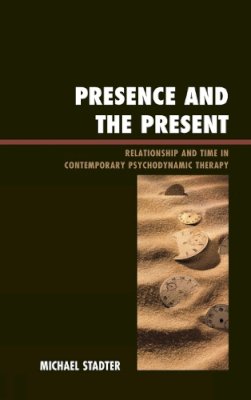
Stock image for illustration purposes only - book cover, edition or condition may vary.
Presence and the Present
Michael Stadter
€ 147.30
FREE Delivery in Ireland
Description for Presence and the Present
Hardback. Series: Library of Object Relations. Num Pages: 288 pages. BIC Classification: MMJT. Category: (G) General (US: Trade). Dimension: 239 x 163 x 23. Weight in Grams: 576.
Presence and the Present: Relationship and Time in Contemporary Psychodynamic Therapy offers salient points learned from the author’s forty years of practice and teaching, and applies psychodynamic psychotherapy to the contemporary practice climate. Emphasizing the therapeutic relationship and the dimension of time, it grounds the discussion in clinical application. Including more than fifty vignettes and four extended case presentations, the author deconstructs successful interchanges as well as errors. Part I sets out central themes and components of this contemporary view of dynamic therapy while part II examines present-day applications. Part I begins with an overview of the core (the relationship) and the contours (characteristics) of therapy and some of the challenges therapists face today. The ten contours discussed are the frame, uniqueness, not knowing, different types of knowledge, mentalization, the therapist’s use of self, goals beyond symptom relief, integration with nondynamic approaches, integration with neuroscience and therapy outcome research, and, finally, the use of time and space. Following a discussion of these ten contours, the book summarizes evidence-based relationship elements in therapy and the robust empirical research demonstrating dynamic therapy’s effectiveness, while providing a theoretical overview for therapists not familiar with psychodynamic theory. The last two chapters of part I examine the complex relationships among time, life, and psychotherapy and continue the exploration of therapy duration, the present moment, transience, unending therapy, and termination. Part II of Presence and the Present begins with two chapters on the therapy of trauma. Chapters 8 and 9 discuss the phenomena of trauma and include practical recommendations and frequent therapist countertransferences. Chapter 10 focuses on the organization of self experience through bodily sensations and offers a nuanced model to understand physical elements of transferences and countertransferences. The final three chapters explore therapy with couples who are struggling with disturbed adult or adolescent children, integrate cognitive-behavioral interventions with the dynamic approach, and examine the frequent and key affect of shame in psychotherapy.
Product Details
Format
Hardback
Publication date
2011
Publisher
Jason Aronson Inc. Publishers United States
Number of pages
288
Condition
New
Series
Library of Object Relations
Number of Pages
288
Place of Publication
Northvale NJ, United States
ISBN
9780765706553
SKU
V9780765706553
Shipping Time
Usually ships in 15 to 20 working days
Ref
99-15
About Michael Stadter
Michael Stadter, PhD, maintains a private practice in Bethesda, MD. He is author of Object Relations Brief Therapy: The Therapeutic Relationship in Short-Term Work.
Reviews for Presence and the Present
Presence and the Present: Relationship and Time in Contemporary Psychodynamic Therapy makes a truly unique contribution to the field of psychodynamic therapy. In a creative way, it combines a masterful integration of contemporary views of psychotherapy with an illuminating illustration of how a skilled clinician makes use of such an integrated approach. Dr. Stadter also breaks new ground by exploring the phenomenon of time and its relationship to psychotherapy in a most original way. Reading Presence and the Present is a valuable educational experience; one that will enhance the work of anyone engaged in the field of psychotherapy.
Theodore Jacobs, MD, Albert Einstein College of Medicine Dr. Stadter’s book is another critical puzzle piece in learning about the bridge between the mind and the brain. Dr. Stadter, as an expert in relational psychodynamic theory, was able to provide us with the pertinent research from the area of neuroscience supporting the psychodynamic theory. The contribution of this work to the field is significant, as we need to continue to be on the forefront of the effort to understand the workings of the human mind.
Harry Gill, MD, Washington School of Psychiatry This is a book in a rather typical and refreshing American vein. If there is, as I think, an American school of psychoanalysis it is composed of singular authors who write from the pragmatics of experience and then find some way to connect it to one theory or another. Stadter like Giovacchini, Boyer, and others is a clinician first and the theory follows on. This grassroots writing has an honesty that is deeply sincere, intelligent, and will speak to many people who work, day to day, with their patients and in this author will find a kindred soul.
Christopher Bollas, PhD, British Psychoanalytical Society
Theodore Jacobs, MD, Albert Einstein College of Medicine Dr. Stadter’s book is another critical puzzle piece in learning about the bridge between the mind and the brain. Dr. Stadter, as an expert in relational psychodynamic theory, was able to provide us with the pertinent research from the area of neuroscience supporting the psychodynamic theory. The contribution of this work to the field is significant, as we need to continue to be on the forefront of the effort to understand the workings of the human mind.
Harry Gill, MD, Washington School of Psychiatry This is a book in a rather typical and refreshing American vein. If there is, as I think, an American school of psychoanalysis it is composed of singular authors who write from the pragmatics of experience and then find some way to connect it to one theory or another. Stadter like Giovacchini, Boyer, and others is a clinician first and the theory follows on. This grassroots writing has an honesty that is deeply sincere, intelligent, and will speak to many people who work, day to day, with their patients and in this author will find a kindred soul.
Christopher Bollas, PhD, British Psychoanalytical Society
